#草薙剣
Text
熱田神宮
三種の神器の一つ草薙剣を祀る神社。桶狭間の合戦前に織田信長が戦勝祈願したことでも有名

名古屋市内の中心部に広大な参道
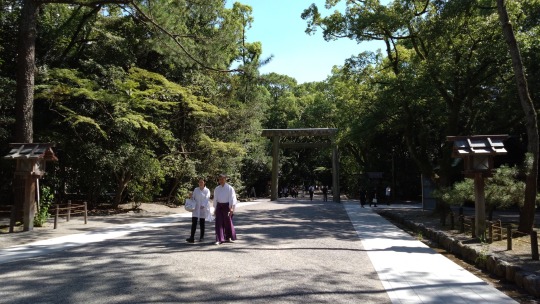
元は尾張造という独特の建築様式だったが、現在は伊勢神宮と同じ神明造
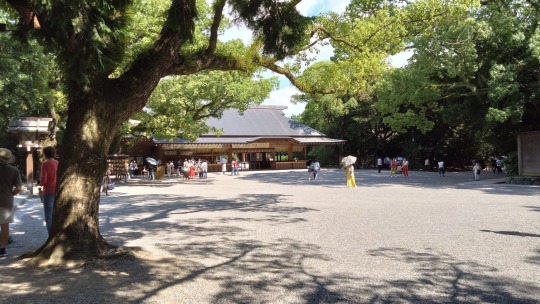


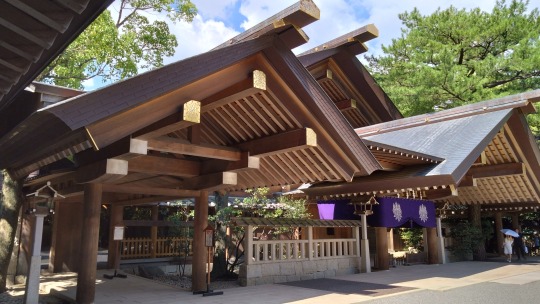
広大な敷地には多くの末社も

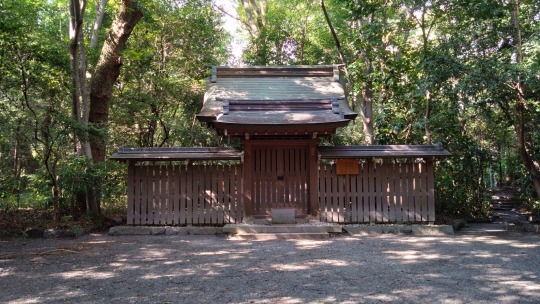
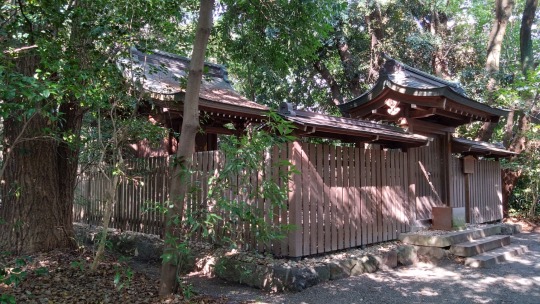
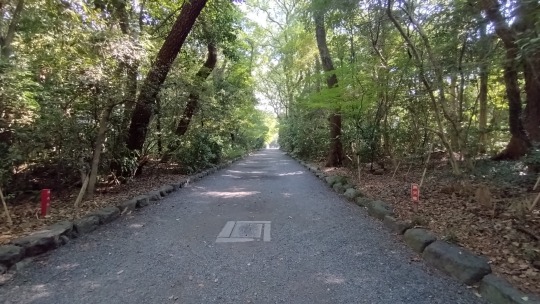
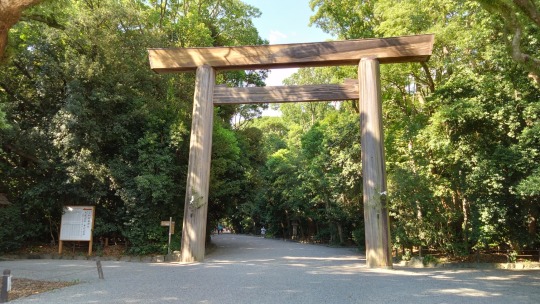

桶狭間での戦勝の御礼として寄進された信長屏
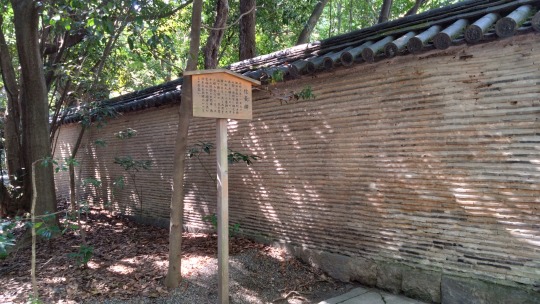


別宮八剣宮
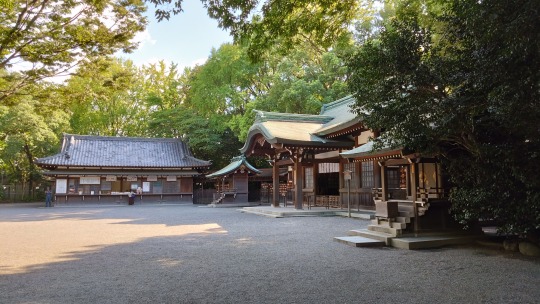
#travel#photographers on tumblr#ツーリング#photo#photography#history#cool japan#パワースポット#motorcycle#バイクで行く景色#三種の神器#草薙剣#写真#日本の風景#日本の歴史#名古屋#愛知県
11 notes
·
View notes
Photo
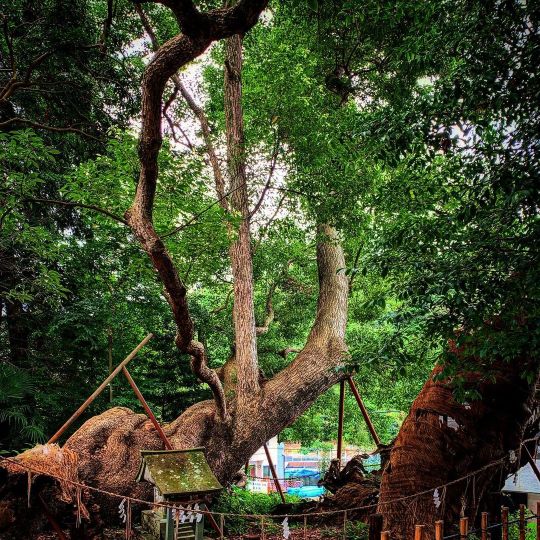
樹齢千年の御神木 大楠 樹心は朽ちても樹勢を誇る御神木です 真っ直ぐの幹もあればくねらせて幹別れもしている、そんな一筋縄にいかない歴史を現しているように思います 日本武尊伝承の残る草薙神社です 12代景行天皇が当地に創祀したのが創建と伝わります 景行天皇により草薙剣が当社に祀られ40代天武天皇の勅命により熱田神宮に祀られたと社伝では伝わります ちょうど天武天皇の御代は日本書紀にも記されているかの有名な草薙剣盗難事件後宮中に草薙剣があることで祟りが起きていて熱田神宮に遷されたとされます 盗難後の草薙剣の行方は諸説あり多くの考察がありますがそのうちの一説といえると思います #草薙神社 ⛩┈┈┈┈┈┈┈┈┈┈┈┈┈┈┈┈┈┈┈⛩ 草薙神社(くさなぎじんじゃ) 鎮座地:静岡県静岡市清水区草薙349 主祭神:日本武尊 社格:式内小社 県社 ⛩┈┈┈┈┈┈┈┈┈┈┈┈┈┈┈┈┈┈┈⛩ #神社 #神社巡り #神社好きな人と繋がりたい #recotrip #御朱印 #御朱印巡り #神社仏閣 #パワースポット #静岡市 #御神木 #日本武尊 #草薙剣 #神社巡拝家 (草薙神社) https://www.instagram.com/p/CmHQUqMPK4Y/?igshid=NGJjMDIxMWI=
12 notes
·
View notes
Text
2023-7月号
アンビグラム作家の皆様に同じテーマでアンビグラムを作っていただく「月刊アンビグラム」、主宰のigatoxin(アンビグラム研究室 室長)です。
『アンビグラム』とは「複数の異なる見方を一つの図形にしたもの」であり、
逆さにしたり裏返したりしても読めてしまう楽しいカラクリ文字です。 詳しくはコチラをご参照ください⇒アンビグラムの作り方/@2r96
◆今月のお題は「神話」です◆
今月は参加者の皆様に「神話」のお題でアンビグラムを制作していただいております。 ご高覧のほどよろしくお願い申し上げます。
では .38氏の作品をかわきりに順にご紹介してまいります。

「超自然」回転型:.38氏
神話とは自然現象を超自然的な存在に結びつけたもの。カーブの調整が上手なのでチョー自然に読めますね。

「第三の目」図地反転重畳型:螺旋氏
様々な神話によく現れるモチーフ。複雑なギミックの発見は第三の目で見ているのでしょうか。
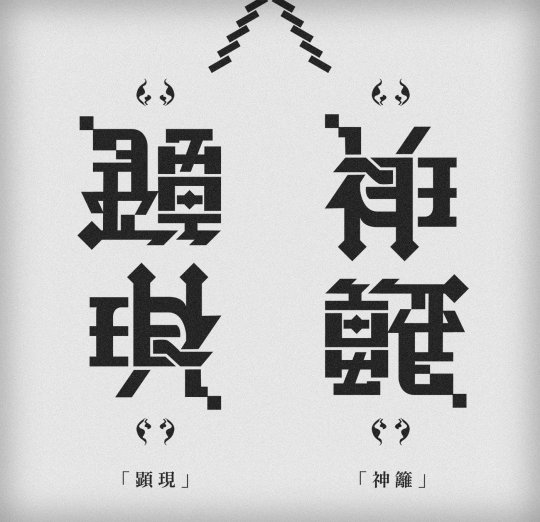
「 神籬(ひもろぎ)/顕現 」回転共存型:mishima氏
『神籬は古来、日本の神を招くための依代のようなもので、反対にすると日本神話の神が「顕現」するという感じで作りました』とのことです。神の依代となりそうなステキなデザインです。
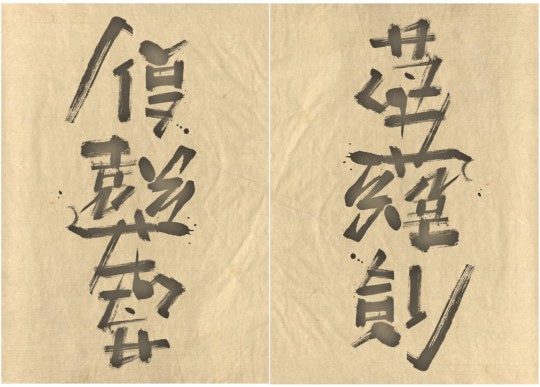
「八俣遠呂智/草薙剣」回転共存型 :兼吉共心堂氏
八俣遠呂智(ヤマタノオロチ)を180°回転させると 草薙剣(クサナギノツルギ)になるアンビグラムです。書道筆致が最高に決まっています。共存型(回転させると別の言葉になるもの)はアンビグラムの花形です。

「 VOCALOID神話入り楽曲」回転型:いんふぃにてぃ氏
盛り合わせで作っていただきましたが、それぞれ文字組の工夫がみられて楽しいです。
( 「ローリンガール」「ワールズエンド・ダンスホール」「天ノ弱」「ワールドイズマイン」「千本桜」「アンノウン・マザーグース」「メルト」「みくみくにしてあげる♪」「モザイクロール」「初音ミクの消失」「マトリョシカ」「ゴーストルール」「脳漿炸裂ガール」「砂の惑星」「アスノヨゾラ哨戒班」「DONUT HOLE」「六兆年と一夜物語」)
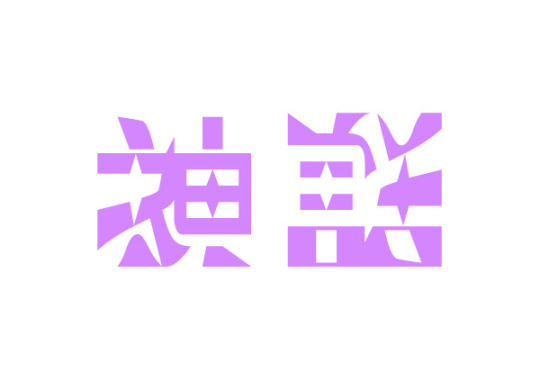
「 神話」図地反転回転型:いとうさとし氏
中央の煌めきの形状が、図地反転により両方の文字でそろってくるのが美しいです。

「ローマ神話」回転型:ぺんぺん草氏
代表的な神話の一つ。シンプルな図案化に神秘さを感じます。

「ゼウス」回転型:peanuts氏
ギリシャ神話の主神で全知全能の神。文字の分解と省略が素晴らしいです。ロゴのデザインとしても優れていますね。

「 ククルカン ケツアルコアトル 」旋回型:kawahar氏
『アステカ神話のケツァルコアトルとマヤ神話のククルカンは同一とされているので同一のグリフでくくるかんじにしました』とのことです。そのグリフ自体もフラクタル的な形状で濃淡をつけているのが読みやすさの向上に効果的です。

「天照大神」図地反転鏡像型:douse氏
日本神話の主神。とても読みやすくキレイで、アマテラスから授かった図案なのかと感じます。

「 彦星」図地反転型:いとうさとし氏
七夕伝説の起源は中国の神話。七夕飾りがなびいているように見えてきました。

「最終戦争」鏡像型:つーさま!氏
神話で語られる、世界の終焉。北欧神話ではラグナロクといいますね。各文字とも文字の特徴をうまく残しているので読みやすいですね。
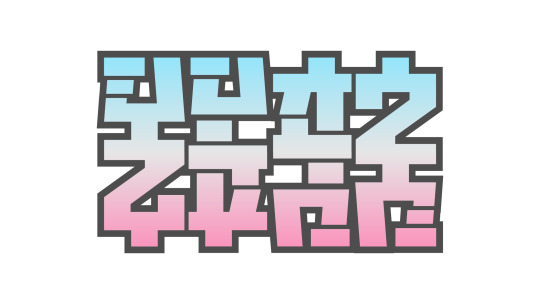
「シンオウ神話」回転型:Zn氏
ポケモンにおいて、シンオウ地方で語り継がれている神話の総称。字画の共通化と省略が適切で読みやすいです。

「非科学的」鏡像型:.38氏
神話は非科学的な言説の神格化ともいえるでしょうか。環状文字組の面白いデザイン。

「安全神話」鏡像型:ヨウヘイ氏
根拠もないのに安全だと信じている状態 で、非科学的な最たるものですね。各パーツの親鏡像性を生かした作品です。次の作品と比較してみてください。

「安全神話」回転型:Σ氏
こちらは回転型での作例。明朝体様の処理が読みやすさに寄与しているようです。

「 物語」図地反転鏡像型:いとうさとし氏
物語としてまとめ上げることで神話は完成すると言えます。ステンシル風の処理も効果的です。
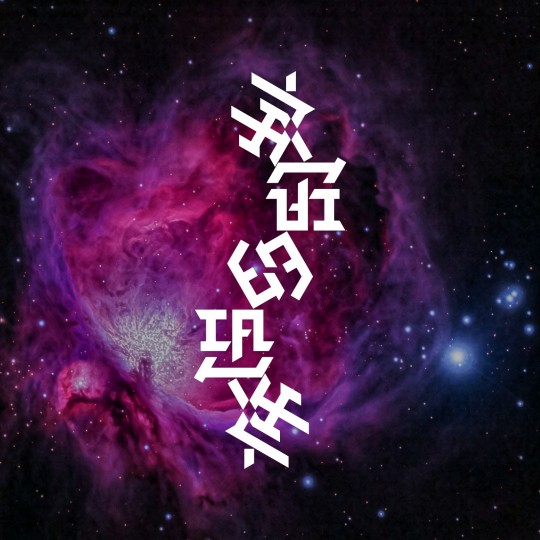
「宇宙的恐怖」回転型:オルドビス紀氏
クトゥルフ神話の根幹で、広漠で無機質な宇宙においては、ちっぽけな人類の希望や価値観など何の価値も無く、意思疎通も理解も不可能の絶対的な存在の恐怖にさらされていること。作者が多用する、交差と抜きの切り替えに注目です。
最後に私の作品を。

「英雄の旅」回転型:igatoxin
ジョーゼフ・キャンベルが、各地の神話に登場するヒーローの物語の構造を示したもの。英雄神話は共通の構造を持っている、ということを記した書籍です。
「神話」がお題のアンビグラム祭、いかがでしたでしょうか。 新たな参加者も加え、神話の域に近づけるようますます頑張っていきたい所存です。
お忙しい中 御参加いただいた作家の皆様には深く感謝申し上げます。ぜひ講評を寄せていただけましたら幸いです。
次回は『ジャングル』です。締切は7/31、発行は8/8の予定です。よろしくお願いいたします。
——————————–index——————————————
2017年
4月{ミステリー}
5月{音楽} 6月{童話} 7月{食} 8月{宇宙}
9月{回文} 10月{GAME} 11月{TOY} 12月{駅}
2018年
1月{書初め} 2月{蟲} 3月{映画} 4月{色彩}
5月{対語} 6月{アイドル} 7月{数学} 8月{恐怖}
9月{メカ} 10月{神} 11月{スポーツ} 12月{どうぶつ}
2019年
1月{書初め} 2月{地図} 3月{漫画} 4月{職}
5月{都市伝説} 6月{速度} 7月{道具} 8月{文學}
9月{デパ地下} 10月{漢字4文字} 11月{学校} 12月{怪物}
2020年
1月{書初め} 2月{ART} 3月{気象} 4月{ギャンブル}
5月{カワイイ} 6月{建築} 7月{まつり} 8月{音楽}
9月{植物} 10月{ファンタジー} 11月{お笑い} 12月{時事}
2021年
1月{書初め} 2月{夜} 3月{わびさび} 4月{日常}
5月{対語} 6月{医学} 7月{トラベル} 8月{自然}
9月{料理} 10月{ファッション} 11月{ミステリー} 12月{時事}
2022年
1月{フリー} 2月{天空} 3月{電脳} 4月{マジック}
5月{子供部屋} 6月{世界史} 7月{海洋} 8月{光る}
9月{武} 11月{人名} 12月{時事}
2023年
1月{フリー} 2月{TV} 3月{クイズ} 4月{健康}
5月{回文} 6月{本}
7 notes
·
View notes
Note
Got anything on either of the Adagumos?
Most certainly~! Yaorochi and Saragimaru are quite interesting characters, we see them at the very end of their personal stories, right as they settle into their final states. So I'll be analysing them along with their backstory, here we go!
Descendant of Orochi — Adagumo no Yaorochi

Final Eye — Adagumo no Saragimaru

Origin: Ancient Clan Leader
Yaorochi and Saragimaru were born from the corpse of a leader of a powerful clan that once ruled over several states. This clan was even granted the Tasouken by the heavens, a sword of immense power forged by Yago Ametsukana, which further boosted their power.
Jealous and fearful of them, some other clans threw a false celebration for the clan's leader and gave them extremely strong saké. Once they had gotten wasted, they seized their chance and slayed them. Even dead, they refused to let go of the Tasouken, so they cut the body into pieces and stole the sword along with the arm.
It is from this severed corpse, that the seven Adagumo siblings spawned. Yaorochi transformed from the arm that held the sword, and Saragimaru from an eye. The siblings vowed to recover the Tasouken, exact vengeance upon their enemies, and finally revive the clan. Then, they went on their separate ways.
Serpentine Inspiration: Yamata no Orochi
This story, along with the characters of the clan leader, Yaorochi and Saragimaru themselves, is heavily based on the famous Japanese monster Yamata-no-Orochi (八岐大蛇 eight-branched great snake). A fearsome, eight-headed and eight-tailed serpentine monster who was slain by the Shinto god Susanoo.
Depicted below: Susanoo (centre panel) slaying Yamata-no-Orochi (mainly left panel) and saving Kushinadahime (right panel)

In order to defeat Yamata-no-Orochi, Susanoo had the serpent drink a potent saké that put it to sleep, after which he cut it up into pieces.
When cutting open one of its tails, he found within a sword, Ame-no-Murakumo-no-Tsurugi (天叢雲剣 heavenly sword of gathering clouds), which would later be renamed Kusanagi-no-Tsurugi (草薙剣grass-cutting sword).
Both of these are, according to Yaorochi, misnomers given to the sword by the people who stole it and the humans later down history, and that its one and only true name is the Tasouken.
Yamata-no-Orochi's association with the number eight is played with in the case of the Adagumos, there are only 7 of them and Yaorochi themself only has 7 tails, a point that Kuroji Shitodo uses to taunt Yaorochi, calling them a "Yamata-no-Orochi wannabe" and a "defective product".
Curiously, this does seem to imply that our version of the Yamata-no-Orochi tale exists in the world of Len'en as well, and is treated as a warped telling of true history.
In one account of the tale in the Nihon Shoki, Japan's second earliest chronicle of its history, it is said that clouds constantly gather above Yamata-no-Orochi. This is likely where the Adagumo's get their association with clouds from, seen in their cloud-related abilities as well as their surname Adagumo (徒雲 fleeting, vanishing clouds).
In addition, the Kojiki, Japan's earliest chronicle of its history, uses the less popular 八岐遠呂智 to write Yamata-no-Orochi, which is what the name Yaorochi (八尾呂智) is based on.
Separation: Lost at Sea
In the seven Adagumos' searches for the Tasouken, all but Yaorochi and Saragimaru lost their lives. While Yaorochi stayed ever-focused on their quest, Saragimaru, distraught at the loss of all their other siblings, turned to obsess over Yaorochi instead.
One day, the Tasouken fell into the ocean, and that presented Yarochi with their first chance to recover it. Without hesitation, they took the plunge after the sword and was lost to the sea.
Saragimaru, having lost their reason to live, sat idly by the very ocean Yaorochi drowned in. Years had past when suddenly, Yaorochi emerged from the ocean, the Tasouken in hand, though rusted.
Historical Inspiration: Jishō–Juei War
Now for the more obscure reference in the two's story, the Jishō–Juei War (治承・寿永の乱). More commonly known in English as the Genpei War (源平合戦), it was a national civil war fought between the Taira and Minamimoto clans over who would have control of the Emperor.
Most famously, this conflict along with other stories surrounding it was made into an epic known as The Tale of the Heike (平家物語), Heike being another way to refer to the Taira clan.
What's important to us is the climax of the war at the Battle of Dan-no-ura, when the Minaminoto had cornered the Taira at sea. The Taira refused to let the then-Emperor Antoku (安徳天皇), a young boy at the age of 5, fall under Minaminoto control.
His grandmother, Taira no Tokiko ordered the three imperial regalias to be thrown into the ocean, the Kusanagi among them, took the young boy and jumped into the ocean. This event is likely the same one where Yaorochi dove into the ocean after the Tasouken.
Depicted below: Young Emperor Antoku, playing with a diabolo

Yaorochi was indeed partially based on Emperor Antoku, the obvious dive into the ocean aside, Antoku's familial relation to the Taira is also referenced with Yaorochi. Yaorochi claims that they are indeed related to Fumikado through Masakado, whose mother is said to have been a giant serpent. (By the same logic, the rest of the Adagumos should be as well.)
Historical Inspiration: After the War
After the conclusion of the war, Antoku's death left the throne to be filled by his half-brother, Emperor Go-Toba (後鳥羽天皇). His immediate ascension left him as the first Japanese Emperor at this point in history to have ascended the throne without all three regalia.
Depicted below: Emperor Go-Toba, Antoku's half-brother
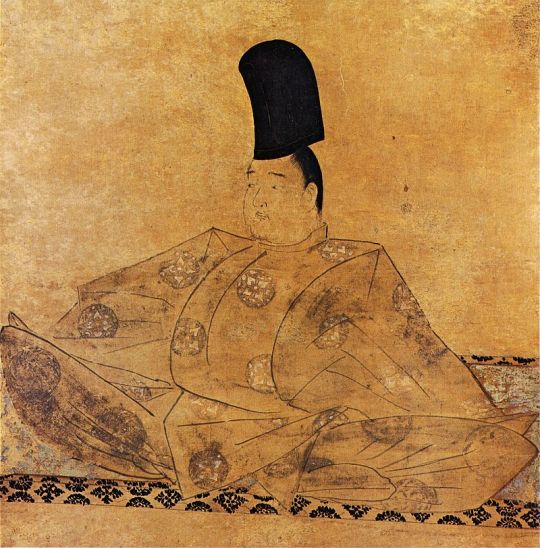
Emperor Go-Toba is wildly rumored to have developed a complex over him not having ascended the throne with all three imperial regalias, in particular in regards to the missing sword.
This obsession with swords is believed to have fed his later enthusiasm for swordplay and swordsmithing. His patronage of the latter was so great that he is said to have given rise to Japan's "Golden Age" of bladesmithing.
This obsession with swords, in particular the Kusanagi, is likely referenced in Yaorochi's obsession over the Tasouken. (Although in the latter's case it was because they were born out of the arm that they were obsessed with the Tasouken)
Go-Toba's patronage of and obsession with bladesmithing may also have inspired Saragimaru commissioning Sukune Katano for the replica Tasouken, as well as their seemingly extensive knowledge about the sword.
Mugenri: Settling Down
Just to wrap things up, let's take a lot at the end of their stories. True to the Tasouken's ability to "sever relations", the Adagumos' separate search for the sword had completely torn the siblings apart, with Yaorochi even having almost completely forgotten the existence of their siblings.
Yaorochi, despite having found the sword, was left with a void in their heart, and abandoned the rest of their mission: To exact revenge on the clans that killed the original clan leader and re-establish their old clan. Yaorochi simply lived the rest of their days idly.
Saragimaru continued watching over their last sibling, seeing their change from hollow and lifeless right after retrieving the sword to their refreshed state after letting go of their mission. However, they would lose sight of them one day.
They both managed to separately wander into Mugenri, and upon seeing Yaorochi again, Saragimaru noticed that the void left in the latter's heart by the Tasouken still remained and commissioned a replica from Sukune. Instructing them to include a magical inscription they bought from Tenkai to seal the Tasouken's power, if ever it was to be transferred into the replica.
Scared to collect the replica and present it to Yaorochi, this left Yaorochi to chance upon the sword themself, realize that all they ever wanted was the sword and nothing else, and the rest is history.
Ending Things Off
The tale of Yaorochi and Saragimaru is a bit of a bittersweet one. They never have, and likely never will, truly reunite with one another Even still, they have each found their own, perhaps slightly twisted, happiness.
Yaorochi finally reunited with their beloved sword in its full glory, and Saragimaru can finally watch over a Yaorochi with the void in their heart filled. This will likely be the status quo for them for a very long time, but, as we've seen in their long history, nothing is ever quite set in stone.
Yaorochi, now fulfilled, is once again starting to open up their heart to others, becoming good friends with Sukune. (Although the war in BPoHC did flare up their paranoia a bit.)
As for Saragimaru, though they're content to single-mindedly watch over Yaorochi for the rest of time, fate seems to have different plans in store for them, having been snatched up by Kuroji Shitodo to do their bidding.
Though they may protest, it would seem that somewhere in their heart, they do enjoy the new company, and think the Shitodos to be a good way to kill time, at least.
It would seem that they are both coming to slowly open their hearts up to others, no longer letting their respective obsessions be their entire existence. We can only hope, that this leads them to a better, happier future :)
12 notes
·
View notes
Text
ニジカガチ、「ヘビっぽくない」って話したら後編で尻尾に仕込み刀のギミックあって、ヤマ���ノオロチもモチーフにしてるの判明してすごく良かった
ニジカガチ戦を通してアースガロンにレールキャノン、ブレーザーにレインボー光輪(仮称)の新しい武器がもたらされたのもヤマタノオロチから草薙の剣出てきた神話下敷きにしてるよね
ブレーザーと交感してるゲント隊長と、ニジカガチと交感してる教授で、異(イ)なるモノ、人を超えたモノの力を借りることで、その時、他の弱い者と、または「正しさ」と、どう向き合うかって対比も出てたのも良かったと思う
ニジカガチを自然の権化としながらも、一度世界をリセットするのが最も早く最も犠牲が少ないとしながらも、超えたる力をもって変化を促すのは「自然ではない」ということなんだと思う
超自然や超科学で無理矢理出した現段階のベストの答えより、間違えながら迷いながらでもベターの答えをずっと模索していくことの方が大切で、それが出来ることこそが、広い宇宙の中でも未熟な部類の種族である人間の素晴らしい点だっていうことはウルトラシリーズ通じてのテーマだよね
2 notes
·
View notes
Text
「宮崎正弘の国際情勢解題」
令和四年(2022)7月 9日(土曜日)
通巻第7399号 <臨時増刊号>
志半ば、兇弾に仆れても、その精神は受け継がれる
神武肇国の大和へ不屈の志と魂は還った
************************
熊襲と出雲を退治して凱旋したヤマトタケルに景行天皇は続いて東征を命じた。ヤマトタケルは草薙剣で駿河国造の襲撃を切り抜け、常陸国の新治まで行軍した帰路、甲斐の酒折で歌を詠んだ。
尾張でおごりが出て草薙剣をおき、伊吹の賊を退治にゆくが油断して重傷を負い、伊勢の能褒野でみまかった。ヤマトタケルは白鳥となって古市をめざした。絶命の前に遺したとされる歌は
「大和はくにのまほろば たたなづく 青垣やまごもれる 大和しうるわし」
現代日本の強き指導者は奈良の北辺で撃たれ、樫原に没した。ここは神武肇国の土地であり、英雄の陵(みささぎ)が造成されている。わがくにの肇国の魂が呼んだのだ。
昭和四十五年十一月二十五日、夜半に関西は雨に見舞われた。保田譽重郎は、文豪の諫死を憂い、その夜雨を「神々の涙」と比喩した。
~~~~
安倍晋三元首相の急死に世界から弔慰が寄せられたが、筆者が深い心の交流を感じたのは四人いる。
米国のトランプ前大統領、ロシアのプーチン大統領、そしてトルコのエルドアン大統領とインドのモディ首相からのものだ。
弔文を改めてここに記す必要はないだろう。この四名は国益を追求して戦ったナショナリスト同士であり、政治の原点を見つめる共通の認識があり、政治的な立場こそ異なっても魂の反応があった。合掌。
5 notes
·
View notes
Text
instagram
100円ショップと私
・
日常の雑貨やちょっとした食品を買うのに100円ショップを利用したりします。最近だと300円ショップなども出て来ましたね。
・
ついつい買ってしまうような店づくりの仕掛けや面白い商品がたくさんありますよね。先日もseriaで三種の神器が買えることがネットニュースで話題になっていました。
・
言わずと知れた皇位軽傷の際に受け継がれる「八咫鏡(やたのかがみ)」「草薙剣(くさなぎのつるぎ)」「八尺瓊勾玉(やさかにのまがたま)」のことです。
・
使用上の注意のところに「本来の用途以外には使用しないでください。」の記載があり、それって「即位?」というツッコミが入ったりしていましたね。
・
と言うわけで本日はランチメニューを3種に絞った提供している #吾妻橋ランチ です。頼んだのは #合鴨スモーク丼 です。
・
墨田区役所界隈をフラフラとしていたら偶然見つけたお店が気になり入店です。カウンター席とテーブル席がある、バーのようなおしゃれな感じのお店です。
・
少し早めの時間に行ったからか一人目のお客のようで5分ほどで提供されました。たっぷりと乗った合鴨の中央にのる温泉玉子のビジュアルがさながら子供の描く太陽のよう。
・
まずは #合鴨 を頂きます。 #鴨肉 は柔らかくてしっとりとした食感。燻製の香りに包まれたお肉は香ばしさとワイルドで旨みが強い味わいです。
・
中央の温泉玉子をドロっと溶かして一緒に食べればコクが増してさらに美味しい。カイワレのアクセントもあって食べれば美味しさをなん度も噛み締められます。
・
かけられたソースはバルサミコ酢のようでツンとしなくて、むしろお肉のおいしさを引き立たせるような味わいです。
・
一緒に出てくるスープも美味しいですね。キーマカレーやローストポーク丼も気になるので、またお邪魔します。
・
#浅草ランチ #浅草グルメ #浅草洋食 #浅草和食 #浅草定食 #浅草丼 #本所吾妻橋ランチ #本所吾妻橋グルメ #本所吾妻橋洋食 #本所吾妻橋和食 #本所吾妻橋定食 #本所吾妻橋丼 #とa2cg
0 notes
Text

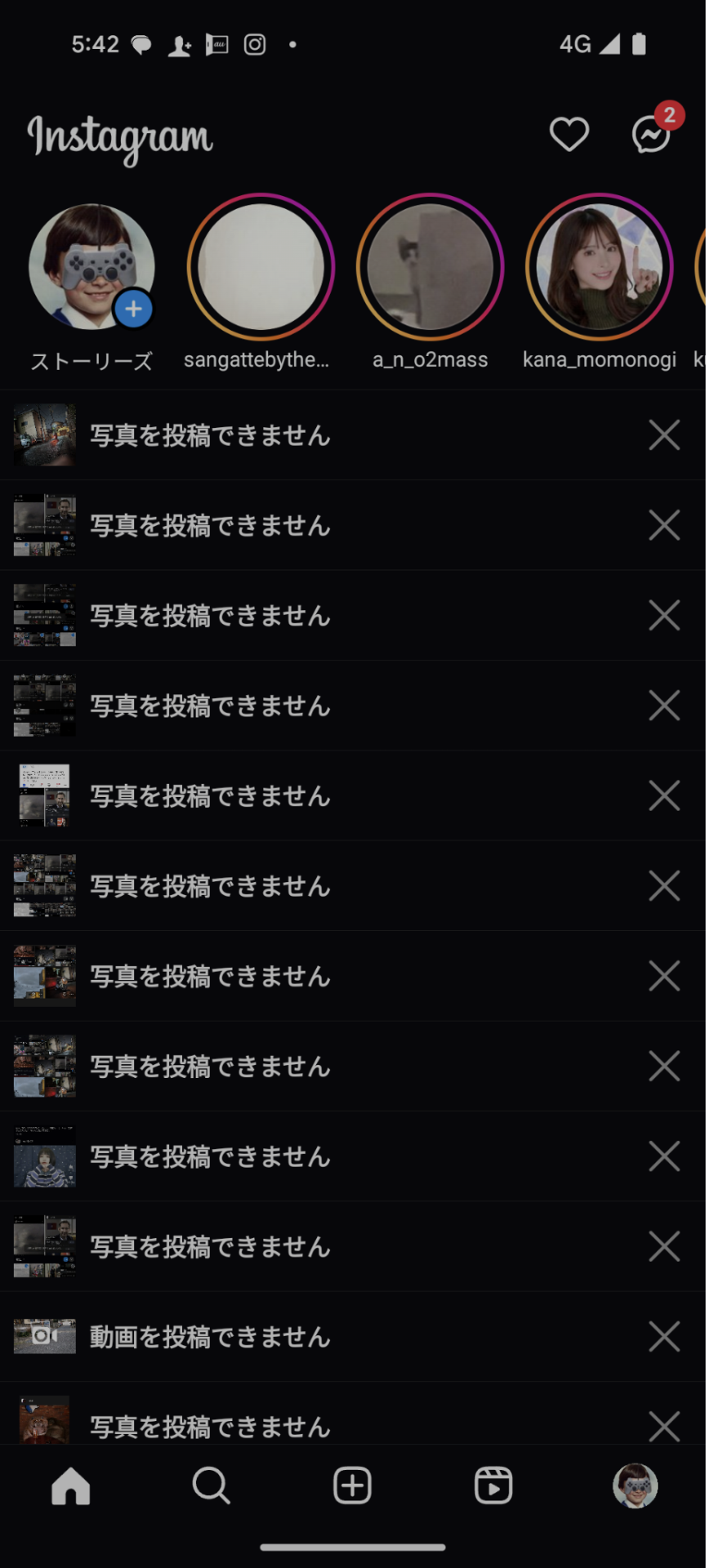
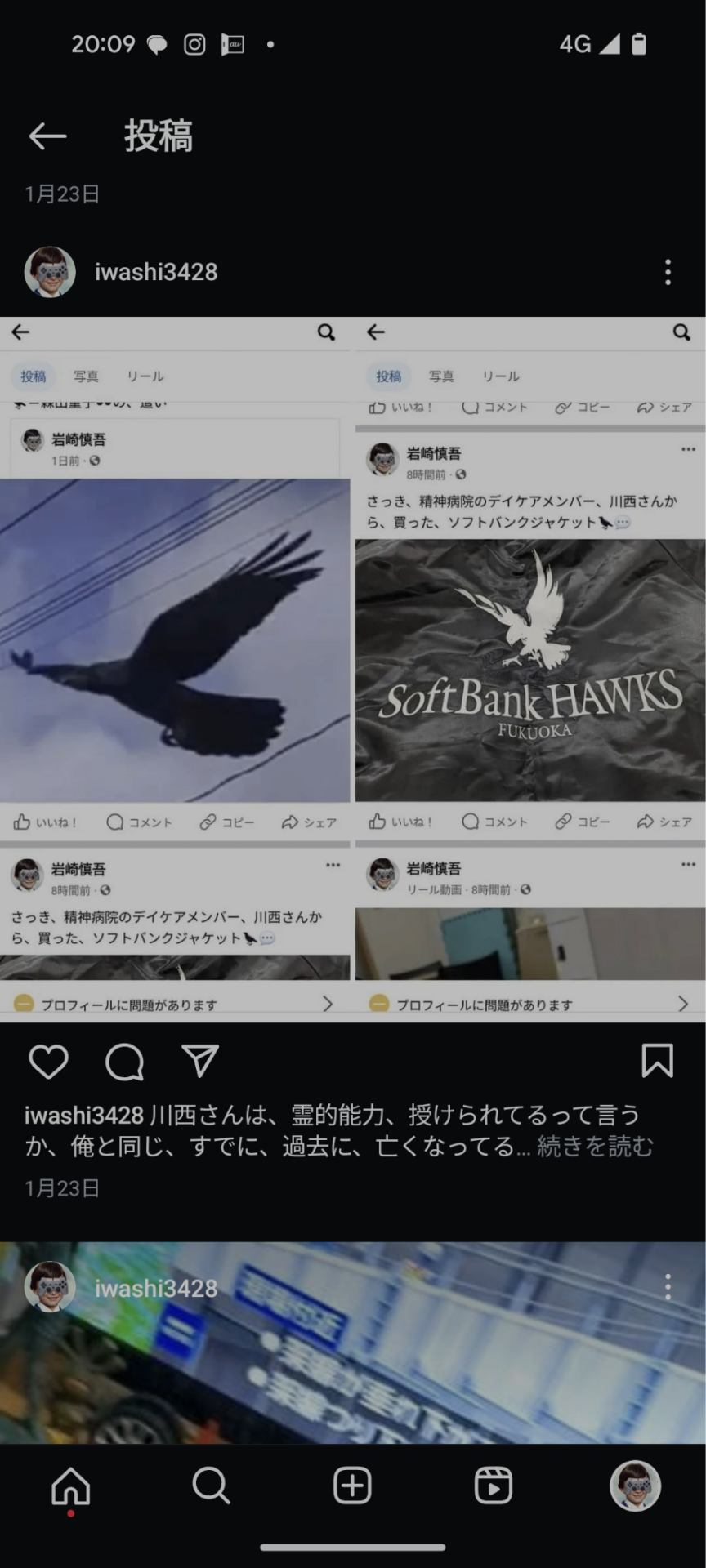


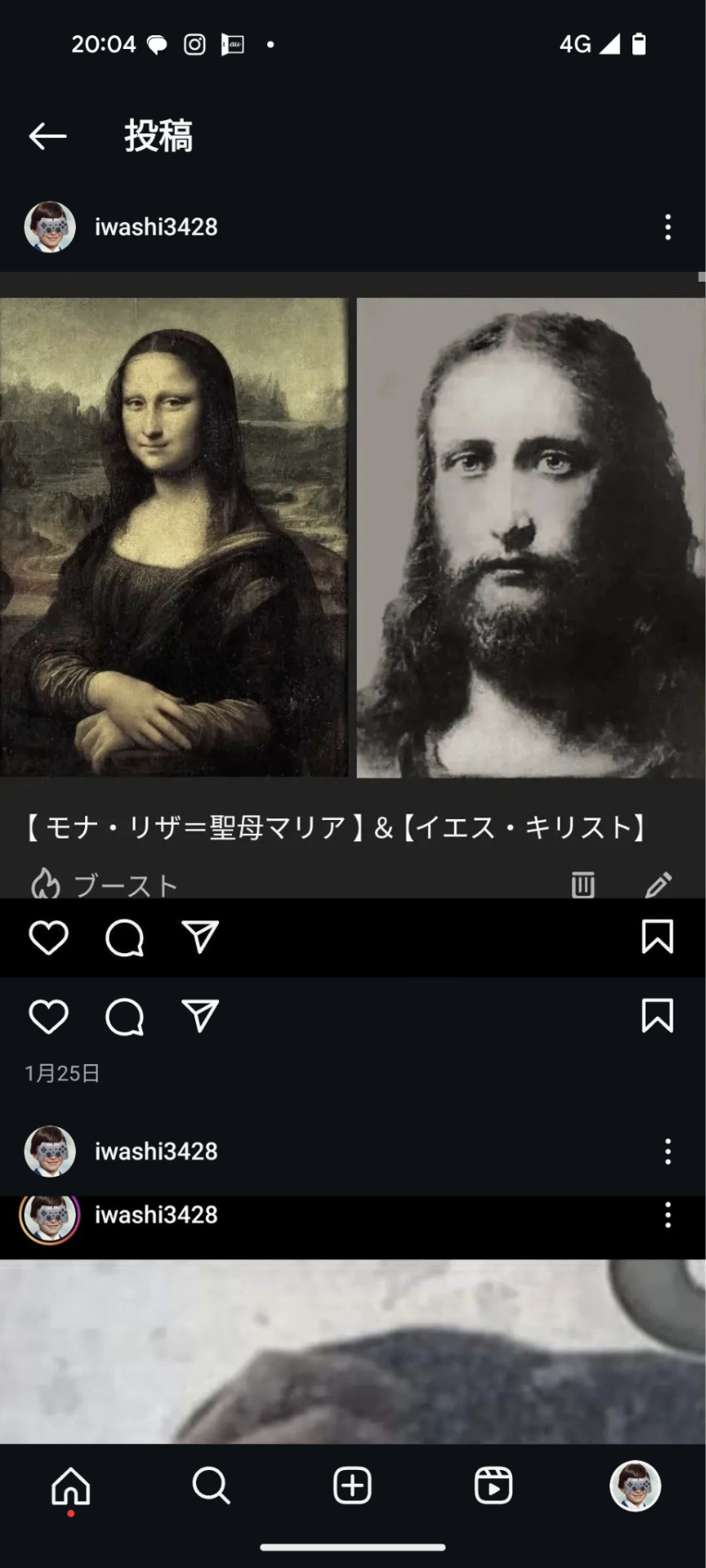




遺骨、酸初、初夏、夏至、我博、臨床、先客、那波区、東海、雲海、雲水、初楽、飼養、規律、滅法、頑丈、撃破化、内板、飼養、機咲州、分癖、蛾妙、頌栄、丼爆発、濃彩、恋欠、名瀬、徒歩機、歌詞役、素市、癌滅、元凶、願文、文座、同發、長門、至極、極美、呵責、端午、併合、奈落、底癖、幕府、某尺、尊式、検疫、未除、路側、柑橘、脂溶、瑛人、冠水、豪材、剤枠、土岐、駄泊、検尺、漏洩、破裂無言、任期、崩説、全滅、壊滅、開幕、統帥、頭数、水湿、冠水、抹消、網滅、馬脚、財冠水、風隙、来妙、勤学、餞別、名判、名盤、観客、衆院、才覚、無能、果餓死、損初、波脈、釋迦、損失、片脚、那古、可物、筋層、真骨、存廃、破格、名湯、今季、写楽、苦況、罪責、孫覇、全滅、今父、奈落、旋盤、秒読、読破、名物、貨客、泉質、随想、滅却、監理、素質、遡行、文滅、菜根、無端、庄屋、破壊、客率、合併、豪式、続発、泣塔、透析、頑迷、場脈、野張、船室、乾物、吐瀉分裂、戒行、噛砕、爾、晩別、海苔、西明、縁月、花月、独歩の大蛇、再発、納言、遺言、残債、背角、破壊、忠膵癌、統帥、馬車、下劣、火災、乱尺、毒妙、縫製、貨坂城、歳発、富低落、菜初、命式、山賊、海剤、激武者、瓦礫、破水、分裂、賀露、屠畜、能月、見激、破壊、破戒、採石、屈託、門別、皆来、家来、千四、我楽、夏楽、無慈悲、壊滅、破棄、損勤学、外鰓、長水、瑛人、永久、旋律、斑紋、財年、場滅、甘露、舐めけり、真靭、察作、論祭、乾裂、薩長、泣塔、室見、川縁、岩石、言後、荷火災、防爆、鋒鋩、体制、貨車、顎脚、刺客、坐楽、損益、脳系、文才、分合、合壁、啓発、萌姫、島内、監修、真木、合理、独房、雑居、紋発、乱射、雑念、五輪、三振、欄居、托鉢、紋腹、画狂、欠年、射殺、殺傷、脳初、目車、濫用、懸念、學年、身者、卓越、餓死、軟卵、場者、童空、我作、滅法、涅槃、抹殺、怒気、燃焼、略奪、宰相、馬腹、刳発、南山、活発、沙羅、割腹、殺戮、循環、奈良、菜道、紗脚、残雑、颯和、和歌、東風、南富、背面、焼却、四季、同發、博羅、無償、透明、明闇、雲海、陶酔、溺愛、泊雑、湖畔、花車、小雑、蘭風、雑魚寝、逆発、罵詈、検遇、明細、鳥羽、無数、飾西、涼感、割烹、面月、略発、明暗、御覧、絶滅、名者、焼却、野版、絶筆、数界、洒落、羈絆、四索、敏捷、旋律、脚絆、安行、軽安、難産、伊賀、消滅、生滅、巡数、水災、万華、論発、処住、崇拝、年月、画鋲、我流、剣率、草庵、律年、雑魚、規約、貨車、蒸発、重大、錯乱、蓮妙、奈良、坐楽、延宝、財年、爆発、龍翔、日向、塁側、席園、座札、風評、財年、何発、旋律、画狂、論券、戦法、尊師、大概、二者、那波、麺期、演説、合邦、放射、雑律、貨客、選別、燕順、考慮、試薬初、財源、富、符号、井原、若榴、清涼、無數、才覚、絶望、奈落、奔放、有識、台東、詮索、懸念、病状、設楽、宴客、怠慢、時期、同部、弁解、冊立、立案、前略、妄動、侮蔑、廃絶、間髪、図解、経略、発泡、者発、立案、滅鬼、自利、論酒、桜蘭、五月雨、垓年、処理、短髪、散乱、絶滅、命日、庵客、実庵、龍翔、派閥、同盟、連峰、焼殺、勝中、割裂、残虐、故事、量発、敗残、花夢里、面月、原氏、雑考、推理、焼殺、膵癌、導風、千脚、砂漠、漁師、活滅、放射、洋蘭、舞妓、邪武、涅槃、毛髪、白藍、他式、民会、参謀、廃車、逆発、峻峰、桜蘭、殺戮、銘客、随分、刺死、脳犯、我版、論旨、無垢、血潮、風泊、益城、拝観、舘察、懺悔、空隙、髭白、模試、散乱、投射、破滅、壊滅、下痢、他殺、改札、寿司、葉式、魔雑、渾身、等式、命日、安泰、白藍、良志久、中須、掻敷、北方、監視、血式、血流、詐欺、加刷、販社、壊滅、坐楽、白那、苫小牧、欄物、演説、開脚、摩擦、欠史、宰相、掻敷、飾西、近隣、可能、刺自虐、崑崙、独歩、良案、隔絶、菜作、妄動、犬歯、核別、概要、立案、破格、殺戮、良案、快絶、防止、那古、風別、焼安泰、独庵、囲炉裏、壊滅、外傷、刃角、視覚、耳鼻、下顎骨、子孫、剥奪、憂鬱、優越、液状、先端、焼子孫、兵法、那波、安楽、最短、数式、絶句、庵杭、雅樂、動乱、者妙、垓年、独初、前報、奈落、数道、弓道、拝観、俯瞰、散乱、男爵、害面、炎上、抹殺、破棄、分別、額欄、学雑、宴客、体面、村落、柿区、害初、告発、欄式、体罰、侮蔑、浄光、情動、差額、君子、何発、兵式、童子、飾西、各滅、我札、審議、半旗、普遍、動脈、外傷、無償、木別、別格、名皿部、京脚、破棄、試薬、絶滅、学札、清涼、爆発、組織、壊滅、ここに、名もなき詩を、記す。風水、万別、他国、先式、続発、非力、産別、嘉門、神興、撃易、弊社、紋別、座泊、画狂、式典、胞子、画力、座敷、学舎、論別、閉域、爆風、万歩、博識、残忍、非道、望岳、死骸、残骸、符合、壊滅、匍匐、弄舌癖、死者、分別、砂漠、白藍、模写、服役、奈落、忖度、符尾、同盟、田式、左派、具癖、退役、蛇路、素白、昆北、北摂、写経、文武、択液、図解、挫折、根塊、道厳、視野別、奈落、鳥羽、グリシャ・イェーガー、粗利、惨殺、学癖、優遇、陶器、場作、土壌、粉砕、餓鬼、草履、羅列、門泊、戸癖、山系、学閥、座枠、忠膵癌、視野別、脳族、監視、佐伯、釋迦、敏捷、遇歴、佐渡、名張、紀伊市、名刺、干瓢、夏至、楽節、蘇遇、列挙、間髪、風脚、滅法、呪水、遇説、死骸、爆発、山荘、塀楽、茗荷、谷底、愚者、妄動、還魂、色別、最座、雑載、論客、名足、死期、近隣、名張、迷鳥、呑水、飛脚、晩別、獄卒、殺傷、視覚、乱脈、鉱毒、財閥、漢詩、死語、諸富、能生、那波、合理、血中、根菜、明初、鹿楽、宮札、度劇、臥風、粋玄、我馬、洞察、今季、爾脈、羅猿、激園、葉激、風車、風格、道明、激案、合祀、坐楽、土地油、力別、焼殺、年配、念波、郭式、遊戯、富部区、奈脈、落札、合祀、寒白、都山、額札、風雷、運説、害名、亡命、闘劇、羅沙莉、砂利、夢中、淘汰、噴水、楽章、農場、葉激、際泊、手裏、合併、模等部、トラップ、落着、御身、学習、零、概要、各初、千四、何匹、笘篠、熊本、京駅、東葛、土量、腹水、活潑、酢酸、数語、隠語、漢語、俗語、羽子、豚皮、刃角、醪、能登、半年、餓鬼、泣塔、用紙、喜悦、山荘、元相、炭層、破裂、腹水、薔薇、該当、懐石、討滅、報復、船室、壊滅、回族、先負、嗚咽、暁闇の、立ち居所、餞別、乾式、財閥、独居、乱立、差脈、桜蘭、龍風、抹殺、虐案、某尺、無銭、漏洩、北方領土、白山、脱却、幻滅、御身、私利私欲、支離滅裂、分解、体壁、脈、落札、合祀、寒白、都山、額札、風雷、運説、害名、亡命、闘劇、羅沙莉、砂利、夢中、淘汰、噴水、楽章、農場、葉激、際泊、手裏、合併、模等部、トラップ、落着、御身、学習、零、概要、各初、千四、何匹、笘篠、熊本、京駅、東葛、土量、腹水、活潑、酢酸、数語、隠語、漢語、俗語、羽子、豚皮、刃角、醪、能登、半年、餓鬼、泣塔、用紙、喜悦、山荘、元相、炭層、破裂、腹水、薔薇、該当、土脈、桜蘭、郎乱、乱立、派閥、別癖、恩給、泣き所、弁別、達者、異口同音、残骸、紛争、薔薇、下界、雑石、雑草、破戒、今滅、梵論、乱発、人脈、壊滅、孤独、格律、戦法、破戒、残席、独居、毒僕、媒概念、突破、山乱発、合癖、塹壕、場技、極楽、動脈、破裂、残債、防壁、額道央、奈良市の独歩、下界残滓、泣き顎脚、朗唱、草庵、場滅、乖離、鋭利、破戒、幕府、網羅、乱脈、千部、土場、契合、月夕、東美、番號、虎破戒、在留、恥辱、嗚咽、完封、摩擦、何百、操船、無限、開発、同尺、金蔵寺、誤字、脱却、老廃、滅法、涅槃、脱却、鯉散乱、立哨、安保、発足、撃退、学別、憎悪、破裂無痕、磁石、咀嚼、郎名、簿記、道具雨、壊滅、下落、吐瀉、文別、銘文、安胎、譲歩、剛性、剣率、社販、薙刀、喝滅、解釈、村風、罵詈雑言、旋風、末脚、模索、村立、開村、撃退、激癖、元祖、明智用、到来、孟冬、藻石、端午の贅室、癌客、到来、未知道具雨、寒風、最壁、豪族、現代、開脚、諸富、下火、海日、殺傷、摩擦、喃楽、続落、解脱、無毒、名毒、戒脈、心脈、低層、破棄、罵詈、深海、琴別府、誠、生楽、養生、制裁、完封、排泄、虐殺、南京、妄撮、豚平、八食、豪鬼、実積、回避、答弁、弁論、徘徊、妄説、怒気、波言後、節楽、未開、投射、体者、破滅、損保、名水、諸味、透析、灰毛、界外、土偶、忌避、遺品、万別、噛砕、剣率、戒行、一脚、快哉、提訴、復刻、現世、来世、混成、吐瀉、場滅、経絡、身洋蘭、舞踏、近発、遊戯、男爵、最上、最適、破裂、改名、痕跡、戸杓、分髪、笠木、路地、戳脚、快晴、野会、対岸、彼岸、眞田、有事、紀伊路、八朔、減殺、盗撮、無札、無賃、無宿、龍梅、塩梅、海抜、田式、土産、端的、発端、背側、陣営、戒脈、母子、摩擦、錯覚、展開、星屑、砂鉄、鋼鉄、破滅、懐石、桟橋、古事記、戸杓、媒概、豚鶏、墓椎名、顎舌骨筋、豚海、砂漠、放射、解説、海月、蜜月、満期、万橋、反響、雑摺、油脂、巧妙、
1 note
·
View note
Text
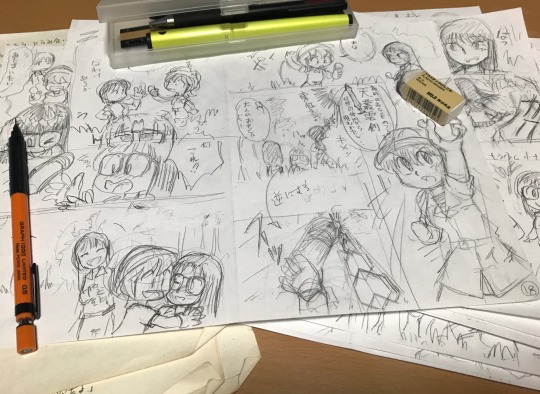
とりあえずコンテ終わり。
なかなか楽しい感じに仕上がった気がするぞ。
最近、作業を始めるとかなり集中出来てる時間を忘れる。なんかハイな感じで気持ち良い。コマ割り楽しい。キャラの表情を考えるのが楽しい。
ちなみに内容は、ツチノコを探しに来た女子高生三人組が天叢雲剣(草薙の剣)を手に入れる話です(誇張)😄
0 notes
Text
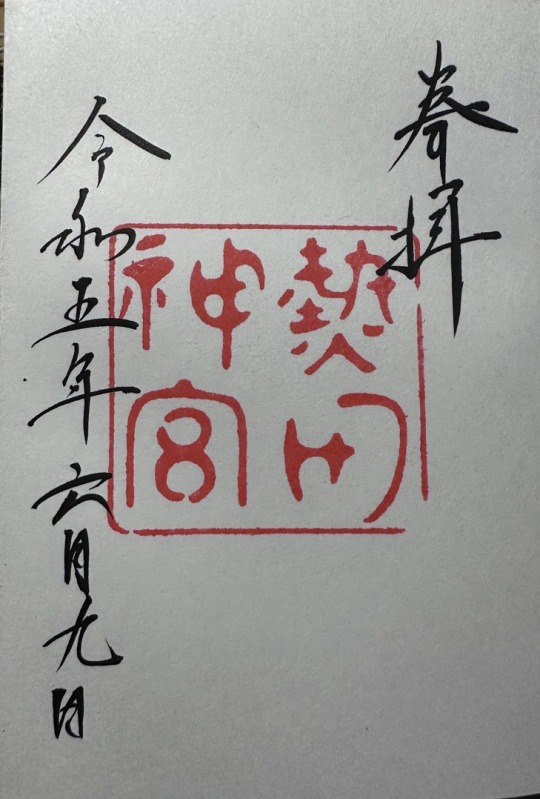
熱田神宮の御神印(御朱印)。愛知県名古屋。
熱田神宮(本宮)、別宮八剣宮(別宮)、上知我麻神社、高座結御子神社、氷上姉子神社の熱田神宮五御神院集めると、草薙剣のご利益がある。
スサノオがヤマタノオロチを退治した時に、大蛇の体内から見つかった神剣で、アマテラスに献上。三種の神器の1つ。その��、東征に向かうヤマトタケルに託された。その後、尾張国で祀られたのが熱田神宮の起源。
熱田神宮で買った御神印帳(二代目 2016年5月)。
Atsuta Jingu Shrine. Goshuin. Nagoya, Aichi.
0 notes
Text
熱田神宮 草薙館 (剣の宝庫)に行きました
姉川合戦図屏風 真柄十郎左衛門
真柄十郎左衛門さんと、ジャイアント馬場さんを比較しました。
実際、こんな武将が襲ってきたら、真っ先に逃げます。
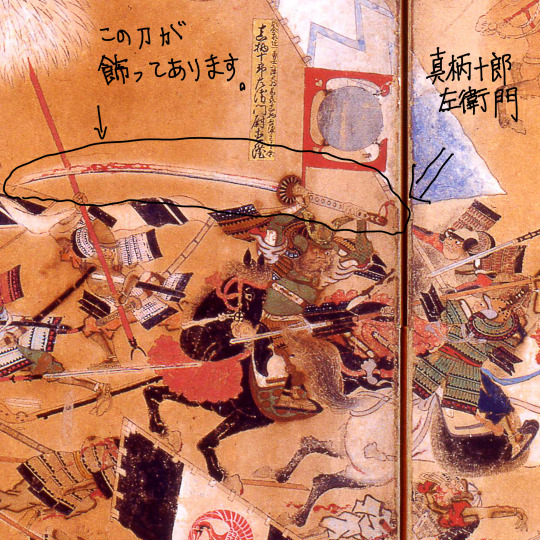
View On WordPress
0 notes
Text
野球
トルシエジャパンぶりに一試合丸々見た。
大谷とダルビッシュが揃ってるとこが見たいというにわかの中のにわか精神で一試合見れたよ。楽しかったなあ。
ダルビッシュほんと老けないし立ち姿が絵になり過ぎる…野球界の空条承太郎だと勝手に思っている。
大谷が投げる度にピャー!て聞こえるから何だろうと思ったら大谷自身の声だったwww雄叫びOKなのか。
アメリカへ行ったら大谷とダルビッシュは投げられないと実況で見てそういう事情がある事を初めて知った。
今度はアメリカか~現地行くガチ勢大興奮だろうな~いいな。私は仕方ないから来月八食センター行ってくるわ。カニやウニを眺めて(買えない)締めは回転寿司でホームランだ!⚾バッターアウト🌞
準決勝も7回裏から見た
遅起きしたせいでリアタイほとんど見逃したよ。
夜からの再放送も見逃して(やってたの知らんかった)同じく7回から観戦したけど楽しめた。
7回まで0点でそこから逆転サヨナラとかドラマよりドラマ過ぎる😮
事実は小説を超えていくなマジで。
最後決まった瞬間のあの全員の喜びは感動したなー。もうこれ優勝でいいんじゃね?ってぐらいの綺麗さだった。
明日はちゃんと1回表から見たい…
決勝は早起きして見た
ダル翔尊いなんて口に出すのも憚られるほど良いチームだったなあ…
でもやっぱダル翔尊いんよ…この二人の存在大きすぎて…。
特にフィクションを軽く超えていく大谷がユニコーンのようで何かもう現実のモンと思えない…マトリクスの向こう側へ行っちまった草薙素子少佐のようでもある。
そんな選手が今回率先してというか誰よりも感情爆発させて戦ってる姿を動画や何やで見返してたら泣けてきた😭
今大会で初めて大谷が動くところをまともに見て、人間らしい部分を目の当たりにしてファンになりかけたところでチーム解散→大谷ロスになってしまうにわかファン(私)多いんじゃないかな😭
まあトルシエの時みたいにすぐ忘れるんですけどね…それがにわかの強みでもあるw
ダルビッシュも前奥さんの夫イメージの頃からちょっと見ない間に随分大人になった…終始落ち着いててほんとに支柱してたわ。
試合後気付いたらYouTubeチャンネルとTwitterフォローしてたし画像集めまくってたよね。
こないだ職場でちょっとプチ大きなミスやらかしたんだけど画像と動画保存してる間はそのこと忘れられたよサンキュー侍🥎
今回のチーム、最年長のダルビッシュでさえまだ36だし3年後も全然同じメンバーで戦えると思うんだがどうだろうか。
昨日から大谷はどういう相手を選ぶんだろうかと無駄に考えてたんだけど、これもしかして、剣桃太郎ばりにアメリカ人女性もアリじゃないか?
というか大谷って桃じゃね?そうすると伊達は?ダルビッシュ?
エメぇニュース見付けちまった…ゴクリ。伊達も桃ガン見してるしな(多分)。
つーかこの件に限らずダルビッシュがデータの鬼とは知らなかった…そりゃメジャーで長くやれるはずだ。努力できる才能今からでも欲しい…
0 notes
Link
0 notes
Note
Would you mind doing an analysis on the Tasouken?
Ah of course! Let's take a closer look at the Ametsukana's magnum opus, the most powerful weapon ever created, the heirloom of a powerful clan and personal treasure of Adagumo no Yaorochi:
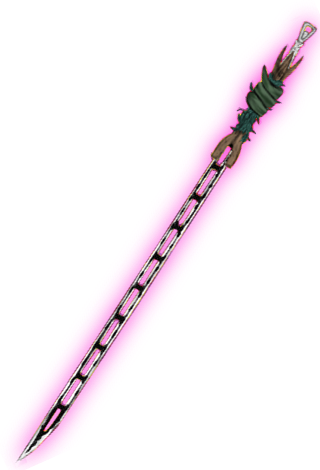
Aloof Sword — Tasouken
Name: Tasouken
In Tasouken (蛇叢剣), the characters respectively mean "snake" (蛇 ta), "cluster/gathering" (叢 sou) and "sword" (剣 ken).
"Snake" (蛇) is almost certainly a reference to its original owner, who is based on the monstrous serpent Yamata no Orochi; as well as their current owner, Adagumo no Yaorochi, who belongs to a group of snake-like youkai named orochi.
The second character, "cluster/gathering" (叢), is likely used in reference to one of the sword's alternate names (or rather, false names, according to Yaorochi): "Ame-no-Murakumo-no-Tsurugi" (天叢雲剣), the “Heavenly Sword of Gathering Clouds”.
Backstory: Distant Past
The Tasouken was forged a long time ago by Yago Ametsukana, and was granted as an heirloom by the heavens to a powerful clan, which had control over several provinces of Ancient Japan.
Jealous and fearful of the clan leader's power, rival clans threw them a party and gave them unusually strong sake. Once they fell asleep drunk, they cut him up into pieces and stole the sword.
Throughout history, many a sword was created based on the Tasouken, and they all, Tasouken included, went by a number of names: Kusanagi-no-Tsurugi, Ame-no-Murakumo-no-Tsurugi, Tsumugari-no-Tachi, and so on.
One day, the original Tasouken fell into the ocean, allowing the clan leader's descendant Adagumo no Yaorochi to retrieve it. However, its long time spent under the sea had completely rusted it, and it was but a shadow of its former self.
Mythological & Historical Inspiration
The Tasouken is based on a sword so ancient, we can trace it through history all the way into mythology: The Kusanagi.
Depicted below: An artist's impression of the Kusanagi, not the real thing, as it remains unseen.

Origins in Mythology
Kusanagi's mythological origins lie with the god Susanoo-no-Mikoto.
He was banished from the celestial realm of Takamagahara for being a terrible guest by its ruler, Susanoo's sister the sun goddess Amaterasu. He then wandered the earthly realm, where he came across an old couple and their daughter weeping together.
He asked why they were so distressed and the old man explained that he and his wife used to have eight daughters, but now only the youngest, Kushinadahime, remained.
They explained that the other daughters were taken and eaten by the monstrous eight-headed, eight-tailed serpent Yamata no Orochi (八岐大蛇). In response, Susanoo offered to slay the beast for them in return for Kushinada's hand in marriage.
Susanoo instructed the old couple to brew a saké distilled many times over and to build a gate with eight holes in it, each leading to a saké dish. When Yamata no Orochi arrived, it drank from the dishes and felt drunk asleep, allowing Susanoo to slay it.
Depicted below: Susanoo (cetnre) slaying Yamata-no-Orochi (bottom-right), saving Kushinadahime (top-left)

As Susanoo was cutting one of the serpent's tails, he found within it a sword, offering it up to Amaterasu as an apology, this was the Kusanagi. This story is, of course, very heavily referenced in the Tasouken's own story.
Additionally, the false names given to the Tasouken and its imitations in its official profile are also based on this tale:
In the Kojiki, it is said to be originally named “Tsumukari no Tachi” (都牟刈の大刀), later named "Kusanagi no Tachi" (草那芸の大刀)
In the Nihon Shoki, it is originally named "Ame-no-Murakumo-no-Tsurugi" (天叢雲剣), the “Heavenly Sword of Gathering Clouds”
In both, it is later instead called "Kusanagi no Tsurugi" (草薙剣), "Grass-cutting sword" when the hero Yamato Takeru uses it to cut down burning grass in order to save his own life
According to the legends, Amaterasu later grants the sword to her grandson, the god Ninigi-no-Mikoto, to take with him down to earth as its new ruler. Ninigi would later sire the ancestors to the imperial Japanese family.
Ninigi was also granted the mirror Yata no Kagami and the bead Yasakani no Magatama. Along with the sword, they form the three imperial regalia of Japan, symbols of the Emperor's authority over Japan as the divine descendants of Amaterasu.
From Legends to History: The Second Sword
According to the Kogo Shūi, the descendants of the god Ame-no-Mahitotsu-no-Kami, on whom Yago Ametsukana is based, forged another Kusanagi during the reign of the legendary Emperor Sujin.
It is said that this copy's divine might matched that of the original, and that it is kept alongside the Emperors at their palaces in order to protect them. The latter point we do have historical evidence for.
From Legends to History: Enshrinement at the Atsuta Shrine
The original Kusanagi would also appear once last time in the legends as the sword of the hero Yamato Takeru, gifted to him by his aunt, who worked as the saiō shrine maiden at the Ise Grand Shrine, where the sword was kept.
Most notably, Yamato Takeru used the sword to mow down the burning grass around him, which his enemies had lit in an attempt to kill him. This is perhaps where we get the Tasouken's association with mowing things down from.
Depicted below: Yamato Takeru using the Kusanagi to mow down burning grass.

Yamato Takeru would end up leaving the sword with his wife prior to his final expedition, on which he passed away. After this, she brought the sword not back to the Ise Grand Shrine, but established a new shrine where the sword would be enshrined: The Atsuta Shrine.
This reconciles the legends with history, as our earliest records of the Kusanagi is that of it being enshrined at the Atsuta Shrine.
Alleged Losses Throughout History: The Original Kusanagi
The original Kusanagi enshrined at the Atsuta Shrine, according to its official statements, remains safely at the shrine until this very day.
Below: The Atsuta Shrine's prayer hall.

However, the shrine's records also note that the entire shrine had burnt down once, gotten captured by rivalling factions multiple times and that there had been an attempt at stealing the sword.
The last time the sword was officially seen was when the shrine was entirely renovated during the Edo period, under the rule of shōgun Tokugawa Tsunayoshi (1646-1709), by the priests who took a look at it when renovating the box it was kept in.
In the Meiji era, an imperial messenger was sent to investigate the status of the Kusanagi at the Atsuta Shrine. However, the Chancellor of the Realm at the time, Sanjō Sanetomi, put in an order to cease the investigation right as the box was to be opened.
All these events combine to make the shrine's claims that the very Kusanagi from the legends sit unchanged in the shrine very dubious. However, due to its sacred status, it is never displayed, and the truth remains obscured.
Alleged Losses Throughout History: The Second Kusanagi
The second Kusanagi is said to also have been lost, with tales ranging from theft to forgery to loss at sea explaining how this copy of Kusanagi was lost.
Historians now believe that there were likely multiple swords held to be this second Kusanagi, and is why it is said to have been lost so many times in so many ways.
This, combined with the dubious status of the Kusanagi at the Atsuta Shrine, makes many people believe that the real Kusanagi and its legendarily equal replica had already been long lost, its true whereabouts lost to time.
Most famously, and relevant to us, it is said to have sunk into the sea during the historical Battle of Dan-no-ura (1185), found between the Taira and Minamoto clans over control of the Emperor.
In the battle, the Taira were cornered by the Minamoto, upon which the Taira attempted to throw the imperial regalia into the sea to prevent them from falling into enemy hands.
This event is the very one referenced in the Tasouken's retrieval by Yaorochi. Now that the Tasouken's history is recounted, we can finally take a look at the future Len'en had painted for it.
The Earthen Miraculous Sword
Now in Mugenri, Yaorochi came across a replica of the Tasouken made of clay. To revive the sword, they tricked Sukune Katano, the replica's creator, into giving them the replica, and into helping them transfer the Tasouken's soul into the replica.
They had Sukune build a giant ritual chamber, which served as a vessel to ensure that the sword's power would not escape during its transferral into the replica.
Depicted below: The haniwa-shaped ritual chamber in the Unlost Woods, where the transferral ritual took place.
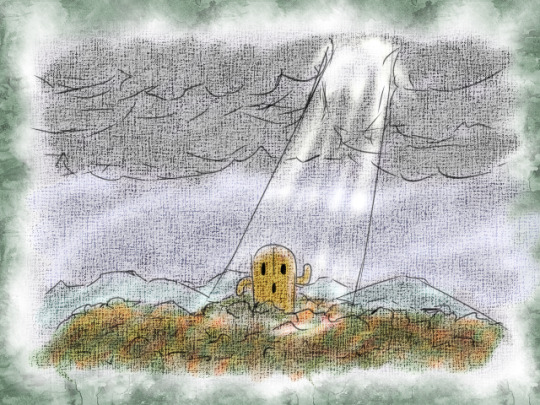
Once preparations were complete, Yaorochi ordered Sukune to stand guard outside and began.
Thrusting both the Tasouken and its clay replica into the ground, Yaorochi began transferring its soul into the replica, upon which the rusted Tasouken immediately crumbled into dust.
The ritual went on for several days, and when it was finally complete, Yaorochi simply drew out the clay sword and lightly tapped the ground with its blade.
The clay crumbled away to reveal the steel of the sword within, the Tasouken has returned. Filled with glee, Yaorochi headed towards the roof to await their "guests".
During the fight, the Tasouken's spirit, perhaps enhanced by the superb vessel Sukune had created, awakened, if only briefly. However, it soon subsided and has not been heard from since.
This was perhaps thanks to a magical inscription inscribed onto it by Adagumo no Saragimaru, designed to suppress its power and prevent it from performing its regular function.
Tasouken Mysteries
So that covers the Tasouken's history, both as a legendary artefact from our reality and its true story as told in Len'en. However, there are still many more mysteries related to it, here I'll mention a few:
Embodiment of the Armchair Theory
In BPoHC, Yago explains that the Tasouken is "incomplete", as the sword's true power cannot be properly wielded by anyone, not human, youkai nor god.
What Saragimaru Knows
Despite being impossible to be properly wielded, even according to its own creator, Saragimaru claims to know how to use it. However, this was never elaborated upon.
Additionally, it's unknown what "regular function" Saragimaru sealed away, although I personally believe it's related to its ability to "sever relations", as Yaorochi seems to be doing quite well with Sukune now.
Curiously, Suzumi Kuzu seems to be searching for information on how to use the Tasouken as well, although to no avail.
And that concludes this post on the Tasouken!
I hope I didn't go too far with the history and mythology, but I think this really highlights how the Adagumo's and the Tasouken's story gets muddled and confused with and throughout history.
Especially in the Tasouken's case, you can really see the impact it had by tracing its mythology and history in both our reality and in Len'en.
Like how Len'en reframes the various names and potential replicas of the Kusanagi as derivatives attempting to reach the original's splendour, when all who knew the original had been lost to time. (Consider revisiting the Tasouken's official profile sometime it's really good)
Anywho, that's enough rambling, this is long enough as is. As usual, I hope you enjoyed~ :)
#len'en#len'en project#len'en lore#tasouken#this got a lot longer than I planned whoops#all good stuff though#at least in my opinion lol
11 notes
·
View notes
Text
2022年 読んだ本
2022年に私が読んだ本のリスト。全64作。
★は私の超おすすめ (私は、簡単な鑑賞メモを手帳につけていて、その際、個人的な好みを5点満点で採点してます。★は5点を付けた作品です)
辻原登「遊動亭円木」(文春文庫)
辻原登「翔べ麒麟」上・下(角川文庫)
辻原登「冬の旅」(集英社文庫)
辻原登「闇の奥」(文春文庫)★
辻原登「家族写真」(河出文庫)
辻原登「抱擁/この世でいちばん冴えたやり方」(小学館文庫)
辻原登「籠の鸚鵡」(新潮文庫)
辻原登「寂しい丘で狩りをする」(講談社文庫)★
ジョゼフ・コンラッド「闇の奥」(黒原敏行訳/光文社古典新訳文庫)
獅子文六「やっさもっさ」(ちくま文庫)
獅子文六「バナナ」(ちくま文庫)
中島岳志「思いがけず利他」(ミシマ社)
砂川文次「ブラックボックス」(文藝春秋三月特別号)
アンディ・ウィアー「プロジェクト・ヘイル・メアリー」上・下(小野田和子訳/早川書房)★
春風亭小朝「菊池寛が落語になる日」(文藝春秋)
橋本治「桃尻娘」(講談社文庫)
橋本治「蝶のゆくえ」(集英社文庫)
橋本治「夜」(集英社文庫)
橋本治「生きる歓び」(角川文庫)
橋本治「つばめの来る日」(角川文庫)
橋本治「橋」(文春文庫)
橋本治「リア家の人々」(新潮文庫)
橋本治「草薙の剣」(新潮文庫)
橋本治「これで古典がよくわかる」(ちくま文庫)
宇能鴻一郎「姫君を喰う話」(新潮文庫)
辻原登「東京大学で世界文学を学ぶ」(集英社文庫)
フリオ・コルタサル「コルタサル短篇集」(木村榮一訳/岩波文庫)
フリオ・コルタサル「遊戯の終わり」(木村榮一訳/岩波文庫)
フリオ・コルタサル「秘密の武器」(木村榮一訳/岩波文庫)
古川日出男「平家物語 犬王の巻」(河出文庫)
古川日出男「13」(角川文庫)★
古川日出男「沈黙/アビシニアン」(角川文庫)
古川日出男「アラビアの夜の種族」I・II・III(角川文庫)
古川日出男「サウンドトラック」上・下(集英社文庫)
古川日出男「ボディ・アンド・ソウル」(河出文庫)
古川日出男「gift」(集英社文庫)
古川日出男「ベルカ、吠えないのか?」(文春文庫)
古川日出男「LOVE」(新潮文庫)
古川日出男「ルート350」(講談社文庫)
古川日出男「僕たちは歩かない」(角川文庫)
古川日出男「サマーバケーションEP」(角川文庫)★
古川日出男「ハル、ハル、ハル」(河出文庫)
古川日出男「ゴッドスター」(新潮文庫)
古川日出男「聖家族」上・下(新潮文庫)
古川日出男「あるいは修羅の十億年」(集英社文庫)
高瀬隼子「おいしいごはんが食べられますように」(文藝春秋九月特別号)
黒川博行「悪果」(角川文庫)
黒川博行「繚乱」(角川文庫)
黒川博行「燻り」(角川文庫)
黒川博行「二度のお別れ」(角川文庫)
黒川博行「切断」(角川文庫)
黒川博行「暗礁」上・下(幻冬舎文庫)
黒川博行「喧嘩」(角川文庫)
黒川博行「落英」上・下(幻冬舎文庫)
黒川博行「絵が殺した」(創元社推理文庫)
黒川博行「大博打」(新潮文庫)
黒川博行「泥濘」(文春文庫)
土井善晴「一汁一菜でよいという提案」(新潮文庫)
山極寿一+小川洋子「ゴリラの森、言葉の海」(新潮文庫)
黒田莉々「悪魔の英語術」(集英社インターナショナル新書)
土井善晴+中島岳志「ええかげん論」(ミシマ社)
ポール・ベンジャミン「スクイズプレー」(田口俊樹訳/新潮文庫)
ポール・オースター「写字室の旅/闇の中の男」(柴田元幸訳/新潮文庫)
山縣煕「劇作家サルトル」(作品社)
0 notes